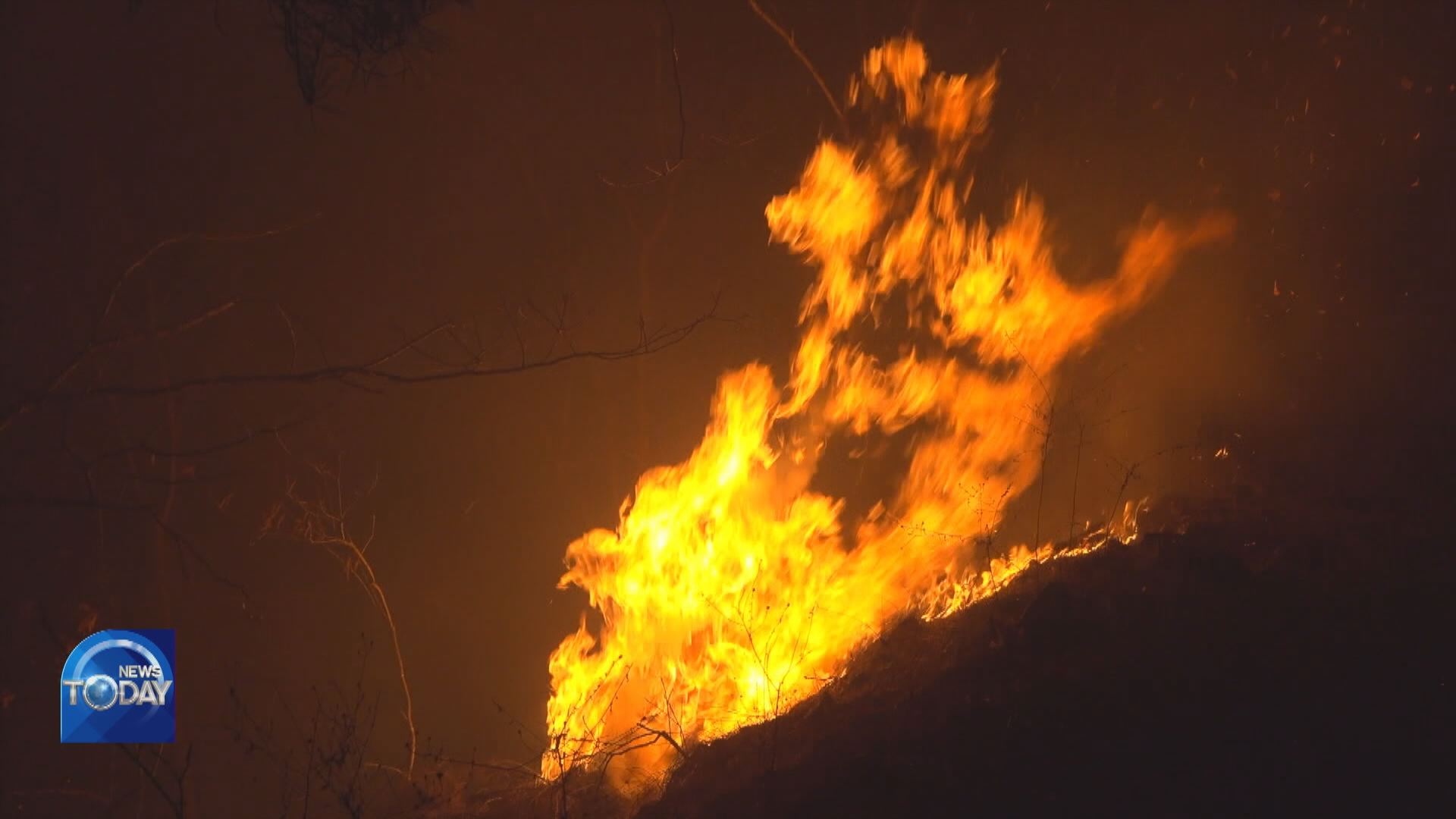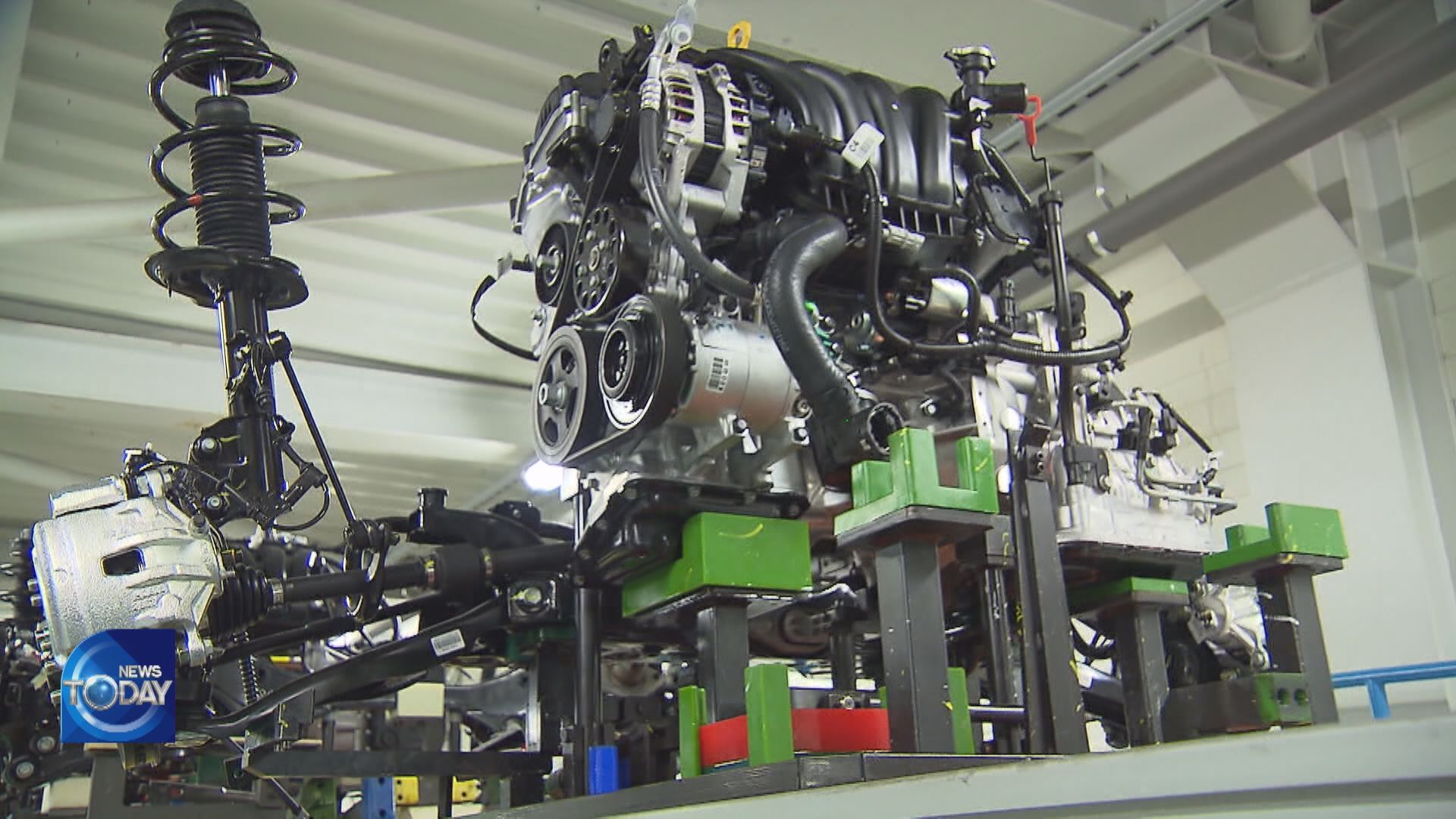FOREST ROAD IN CONTAINING FLAMES
입력 2022.03.16 (15:05)
수정 2022.03.16 (16:45)
읽어주기 기능은 크롬기반의
브라우저에서만 사용하실 수 있습니다.
[Anchor Lead]
The most challenging part of fighting recent wildfires in Uljin and Samcheok was protecting Geumgang pine woods on rogue mountains. A forest road played a crucial part in containing the flames.
[Pkg]
Raging flames spread as close as 500m from Geumgang pine woods due to strong winds. The wildfires almost destroyed the indigenous trees, but thanks to a forest road built there a year ago, they survived. Measuring 5m wide and 7.4 km long, the road played a crucial part in helping firefighters and fire engines approach the woods quickly, unlike on the steep Mt. Eungbong nearby. Pumping wells each containing 6,000 liters of water were installed in four parts of the road to supply water to fire trucks around the clock.
[Soundbite] Shin Jae-soo(Korea Forest Service) : "The forest road helped physically block the spread of inflammable materials such as tree branches and leaves."
Forest roads help take care of forests and transport forest products, but few of them exist in Korea. Currently, an average of 3.6m of forest roads are installed per hectare of forestland in the nation, just 10 percent of the average length installed in Germany and Austria. Japan has 13m of forest roads per hectare of forestland. Funding for building forest roads is provided to local governments through state funds allocated for developing impoverished areas. But oftentimes forest roads are at the bottom of the local governments' priority lists. Moreover, obtaining consent from land owners for installing roads in private woods is not easy.
[Soundbite] Prof. Park Sang-jun(Kyungpook National Univ.) : "Forest roads can greatly enhance the value of forests by boosting forest management efficiency and preventing wildfires. Securing funds for forest roads and raising awareness of their role is important."
The Korea Forest Service plans to increase forest roads to 5.5m per hectare of state forests by 2030 and adorn them with recreational, welfare and sightseeing features to publicize their importance.
The most challenging part of fighting recent wildfires in Uljin and Samcheok was protecting Geumgang pine woods on rogue mountains. A forest road played a crucial part in containing the flames.
[Pkg]
Raging flames spread as close as 500m from Geumgang pine woods due to strong winds. The wildfires almost destroyed the indigenous trees, but thanks to a forest road built there a year ago, they survived. Measuring 5m wide and 7.4 km long, the road played a crucial part in helping firefighters and fire engines approach the woods quickly, unlike on the steep Mt. Eungbong nearby. Pumping wells each containing 6,000 liters of water were installed in four parts of the road to supply water to fire trucks around the clock.
[Soundbite] Shin Jae-soo(Korea Forest Service) : "The forest road helped physically block the spread of inflammable materials such as tree branches and leaves."
Forest roads help take care of forests and transport forest products, but few of them exist in Korea. Currently, an average of 3.6m of forest roads are installed per hectare of forestland in the nation, just 10 percent of the average length installed in Germany and Austria. Japan has 13m of forest roads per hectare of forestland. Funding for building forest roads is provided to local governments through state funds allocated for developing impoverished areas. But oftentimes forest roads are at the bottom of the local governments' priority lists. Moreover, obtaining consent from land owners for installing roads in private woods is not easy.
[Soundbite] Prof. Park Sang-jun(Kyungpook National Univ.) : "Forest roads can greatly enhance the value of forests by boosting forest management efficiency and preventing wildfires. Securing funds for forest roads and raising awareness of their role is important."
The Korea Forest Service plans to increase forest roads to 5.5m per hectare of state forests by 2030 and adorn them with recreational, welfare and sightseeing features to publicize their importance.
■ 제보하기
▷ 카카오톡 : 'KBS제보' 검색, 채널 추가
▷ 전화 : 02-781-1234, 4444
▷ 이메일 : kbs1234@kbs.co.kr
▷ 유튜브, 네이버, 카카오에서도 KBS뉴스를 구독해주세요!
- FOREST ROAD IN CONTAINING FLAMES
-
- 입력 2022-03-16 15:05:56
- 수정2022-03-16 16:45:45

[Anchor Lead]
The most challenging part of fighting recent wildfires in Uljin and Samcheok was protecting Geumgang pine woods on rogue mountains. A forest road played a crucial part in containing the flames.
[Pkg]
Raging flames spread as close as 500m from Geumgang pine woods due to strong winds. The wildfires almost destroyed the indigenous trees, but thanks to a forest road built there a year ago, they survived. Measuring 5m wide and 7.4 km long, the road played a crucial part in helping firefighters and fire engines approach the woods quickly, unlike on the steep Mt. Eungbong nearby. Pumping wells each containing 6,000 liters of water were installed in four parts of the road to supply water to fire trucks around the clock.
[Soundbite] Shin Jae-soo(Korea Forest Service) : "The forest road helped physically block the spread of inflammable materials such as tree branches and leaves."
Forest roads help take care of forests and transport forest products, but few of them exist in Korea. Currently, an average of 3.6m of forest roads are installed per hectare of forestland in the nation, just 10 percent of the average length installed in Germany and Austria. Japan has 13m of forest roads per hectare of forestland. Funding for building forest roads is provided to local governments through state funds allocated for developing impoverished areas. But oftentimes forest roads are at the bottom of the local governments' priority lists. Moreover, obtaining consent from land owners for installing roads in private woods is not easy.
[Soundbite] Prof. Park Sang-jun(Kyungpook National Univ.) : "Forest roads can greatly enhance the value of forests by boosting forest management efficiency and preventing wildfires. Securing funds for forest roads and raising awareness of their role is important."
The Korea Forest Service plans to increase forest roads to 5.5m per hectare of state forests by 2030 and adorn them with recreational, welfare and sightseeing features to publicize their importance.
The most challenging part of fighting recent wildfires in Uljin and Samcheok was protecting Geumgang pine woods on rogue mountains. A forest road played a crucial part in containing the flames.
[Pkg]
Raging flames spread as close as 500m from Geumgang pine woods due to strong winds. The wildfires almost destroyed the indigenous trees, but thanks to a forest road built there a year ago, they survived. Measuring 5m wide and 7.4 km long, the road played a crucial part in helping firefighters and fire engines approach the woods quickly, unlike on the steep Mt. Eungbong nearby. Pumping wells each containing 6,000 liters of water were installed in four parts of the road to supply water to fire trucks around the clock.
[Soundbite] Shin Jae-soo(Korea Forest Service) : "The forest road helped physically block the spread of inflammable materials such as tree branches and leaves."
Forest roads help take care of forests and transport forest products, but few of them exist in Korea. Currently, an average of 3.6m of forest roads are installed per hectare of forestland in the nation, just 10 percent of the average length installed in Germany and Austria. Japan has 13m of forest roads per hectare of forestland. Funding for building forest roads is provided to local governments through state funds allocated for developing impoverished areas. But oftentimes forest roads are at the bottom of the local governments' priority lists. Moreover, obtaining consent from land owners for installing roads in private woods is not easy.
[Soundbite] Prof. Park Sang-jun(Kyungpook National Univ.) : "Forest roads can greatly enhance the value of forests by boosting forest management efficiency and preventing wildfires. Securing funds for forest roads and raising awareness of their role is important."
The Korea Forest Service plans to increase forest roads to 5.5m per hectare of state forests by 2030 and adorn them with recreational, welfare and sightseeing features to publicize their importance.
이 기사가 좋으셨다면
-
좋아요
0
-
응원해요
0
-
후속 원해요
0














![[단독] 위성락 실장 “전작권 협상 카드 아냐…카드로 써서도 안 돼”](/data/layer/904/2025/07/20250713_uwNBPL.jpg)


이 기사에 대한 의견을 남겨주세요.